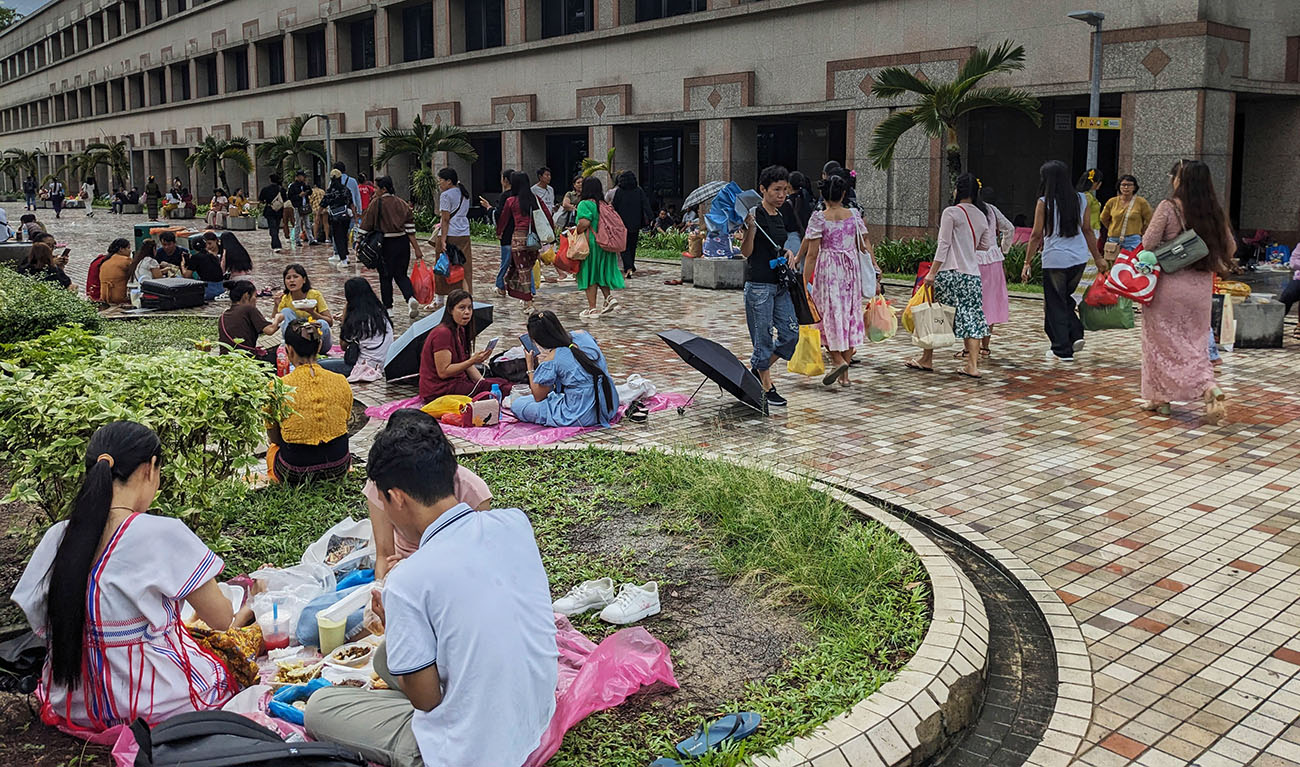
Burmese workers socialising on their rest day, with few options where to go despite an overcast day, threatening rain
Early in 2024, a Burmese construction worker came to TWC2 distressed that his Work Permit had been cancelled by his boss and he was facing the prospect of repatriation. He had left Myanmar in the first place to escape poor job prospects and the looming possibility of conscription as Myanmar slides into civil war. Working in Singapore as a manual labourer despite his college qualifications was both refuge and opportunity. “I love my country, but it has many problems,” the young man told TWC2. “My mother said to me, ‘I want you to be safe, and you must leave.’ ”
We felt we needed studies to better understand their recruitment journeys. Much of our research focus through recent years has been on Bangladeshi and Tamil Indian workers since these formed the great majority of our clientele. Even as we have acquired deep knowledge of these communities’ circumstances and experiences coming to Singapore and working here, we are acutely aware that it is not safe to map what we know of Bangladeshi and Indian workers’ experiences onto other nationalities. Burmese workers are not as concentrated in the construction, marine and process engineering sectors as those from South Asia; instead, they are often seen in the service and manufacturing sectors too. There are also many women among these non-domestic workers unlike the virtually male-only populations from India and Bangladesh.
As a first step, we conducted an online survey to get an overall sense of their experiences. Out of a gross total of 339 responses, we ruthlessly culled the number down to 172 which we were confident met our study criteria: Work Permit holders from Myanmar working in non-domestic sectors.
Although a large percentage (perhaps a majority) of Myanmar nationals working in Singapore are domestic workers, the survey was not designed for them. The regulatory structures and recruitment infrastructure surrounding domestic work are different in several key ways from non-domestic sectors. Nor does TWC2 have many domestic workers in our case work. Moreover, in the interest of comparability with all the other studies we have done with Indian and Bangladeshi migrant workers (among whom domestic workers are rare to invisible), it would be more useful to similarly limit our study to non-domestic workers.
One of the most interesting findings was that 10% of our 172 valid respondents came to Singapore from Thailand. We almost never observe third-country routing in the case of migrant workers of other nationalities. This finding from among the Burmese workers is almost surely related to the political conflict ongoing in Myanmar.
On the other hand, just like other nationalities, a huge majority of our respondents relied on agents to find them jobs. We did not specifically ask if these were Singapore-licensed agencies or unlicensed freelancers – because our sense is that workers themselves seldom know this – but we have strong hints within our data that most intermediaries were operating out of Myanmar (outside Singapore jurisdiction) and even those operating in Singapore were probably in the regulatory shadows.
Nearly 90% of respondents reported having had to bear recruitment costs, almost always in the thousands of dollars. Nearly half of those who had to pay paid an amount in the range of $2,000 – $4,000. Another one-third paid in the range of $4,000 – $6,000. Interestingly, only one respondent (a male construction worker who started work in 2025) reported having to pay a sum greater than $10,000 (he paid $12,800). Among Bangladeshi workers, by contrast, amounts in the range of $10,000 – $15,000 would hardly be unusual.
Since we confined our study to Work Permit holders whose monthly salaries are typically under $1,000 or sometimes a little over that, these agent fee amounts borne by our study respondents likely represented several months’ salaries, even as much as a year.
Our study found that about a quarter of respondents were asked to sign contracts after arrival in Singapore. Having paid large sums in agent fees, such a practice creates an unacceptable vulnerability; terms of employment in the contracts might be poorer than the terms that had been agreed to prior to their taking the jobs, yet workers put in such a position are likely to feel they have no choice but to sign.
In addition, 11% of respondents reported that the job they eventually had to perform was different from what was stated in the official documentation issued by the Ministry of Manpower (MOM). Doing a job different from the official documentation puts them in legal jeopardy.
Overall, some features of Burmese non-domestic workers’ experiences resembled those of Indian and Bangladeshi workers, though we unearthed some interesting differences. This was a smallish, relatively superficial study, but we hope it sets the scene for future, more detailed, studies to follow.

